Log In
View Upcoming Events
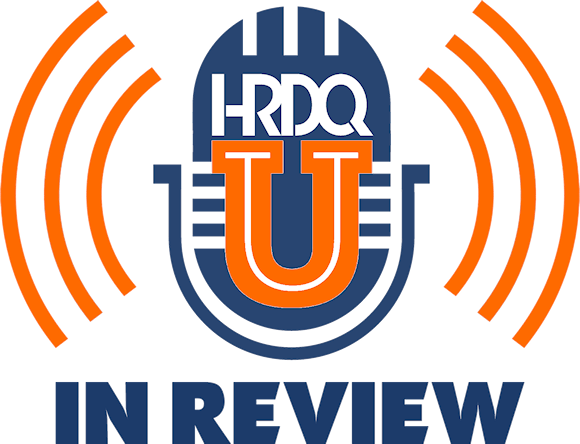
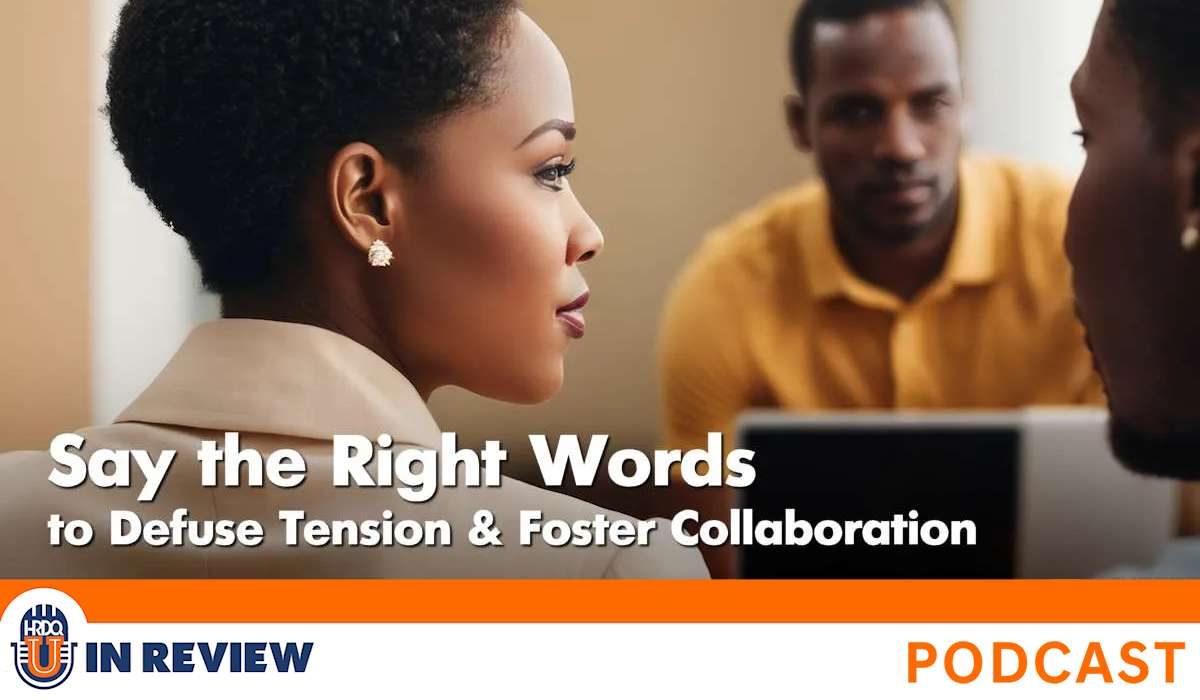
In this episode, host Sarah sits down with David Dye and Karin Hurt, co-founders of Let’s Grow Leaders, to discuss their webinar Say the Right Words to Diffuse Tension and Foster Collaboration. They dive into insights from their latest book, Powerful Phrases for Dealing with Workplace Conflict, sharing practical strategies to navigate tension in the workplace.
David and Karin explore the shift to hybrid learning models post-pandemic, the evolving role of AI in L&D, and the human elements that remain essential in leadership development. They introduce the Synergy Stack, a team collaboration framework built on four key dimensions: connection, clarity, curiosity, and commitment.
The conversation is packed with actionable advice to manage tension in the workplace, including practical phrases for de-escalating conflict, real-world success stories, and tips for fostering a workplace culture of open communication. Tune in to discover how the right words can transform workplace relationships and collaboration!
Chapters:
⏱️ 00:00 – Introduction to David Dye & Karin Hurt
⏱️ 01:49 – Trends in Learning & Development
⏱️ 03:46 – The Synergy Stack Collaboration System
⏱️ 05:28 – Powerful Phrases for Conflict Resolution
⏱️ 07:29 – Key Takeaways & Practical Insights
⏱️ 16:24 – Creating a Culture of Open Communication
Listen now and start using powerful phrases to navigate tension in the workplace with confidence!
00:01
Welcome to this week’s episode of the HRDQ-U In Review podcast, where we bring you the latest insights and practical tools for enhancing soft skills training in your organization. This podcast is brought to you by HRDQ.com, and I’m your host, Sarah, Learning Events Manager at HRDQ-U. Today, we’re joined by David Dye and Karin Hurt to discuss their webinar, Say the Right Words to Diffuse Tension and Foster Collaboration.
00:25
Before we dive in here, be sure to subscribe to our newsletter at HRDQU.com for exclusive updates, upcoming webinars, and resources to help you and your team excel. David, Karin, let’s get started. Thanks so much for joining me today. Absolutely our pleasure. I would love if we could start off here. So this was our first time working together on a webinar. It was such an exciting and engaging session. Could you share a little bit with our audience about yourselves and the work that you guys do?
00:53
Thank you so much, Sarah. Yeah, it was really fun to work with you on that. So we run a global leadership company called Let’s Grow Leaders, and we’re known for really practical tools and techniques for human-centered leaders. And we have written a number of books, and we had the pleasure in the webinar to talk about our latest book, Powerful Phrases for Dealing with Workplace Conflict, What to Say Next to Destress the Workday, Build Collaboration, and Calm Difficult Customers.
01:21
Great. Great. David, do you have anything to add there before we move on? Just that our hope is that everybody will find the right words to start the conversation. If nothing changes, nothing changes. So there’s so much power in finding the right words. And that’s why we share these powerful phrases with everyone. And from your perspective at Let’s Grow Leaders, I would love to know what key trends or changes do you see happening in the L &D space right now?
01:49
You know, it’s interesting because we had the pivot, right? So during the pandemic, everything went to live online and we learned how to do that really well and had opportunities to work with more global clients because of that. What we’re seeing the trend now is now a more of a move back to hybrid. And I don’t mean the hybrid with some people being in the room and some people being virtual because I think that’s the least desirable that a lot of the research is starting to show that. But
02:17
what we’re seeing at the Trend B is, okay, we’d like the space learning over time of being able to be virtual, but we also like to blend that with some of the things that are more impactful when you’re in person. So we’re seeing more and more requests for, come spend a day or two with us, then do live online, and then come and do a capstone. And that is a very, very powerful model. So that’s one of the trends that I’m seeing. David, what would you add?
02:46
Yeah, of course, the other trend that you can’t ignore at this point is the role of AI and artificial intelligence. there are, you know, it’s still very much an unfolding field, especially when we’re talking about learning and development. And there are some cool applications and some different things that people are doing, creating agents and all that sort of thing. And kind of in the moment micro learning. And when you can dial that in, that can be pretty cool. And we’re big believers too, that in the middle of that trend,
03:13
Learning and development and leadership and teamwork, these are people skills. And so you have to have the people element. So our view on that is you can’t replace the people element with AI. You can certainly augment. You can certainly help an advanced intelligence. But you can’t replace. And so there’s got to be a both and there as this trend continues to emerge. Yeah. And that hybrid approach to learning there, it really gives you the best of both worlds, huh? Yeah. Yeah.
03:42
And so what exciting projects or initiatives are you guys currently working on? We are super excited about our new Synergy Stack team collaboration system. And this is based on the four dimensions of collaboration that we talked about in the podcast and that we referenced in our book, connection, clarity, curiosity, and commitment. And then we have spent the last two years really breaking these down into very practical tactical habits.
04:11
So we have this system includes a card deck that has these 48 habits, 12 for each dimension, and then an entire system behind it with facilitator guides and a resource center and videos and articles. So, and then we are certifying people in the system so that HR professionals, L and D professionals can take this, go and have very meaningful conversations with teams
04:41
help them quickly identify the habits that are gonna lead to the success, and then build very practical tactical plans to elevate their performance. And during the webinar, Karin and David went through the four components of the Center Stacks. And I definitely recommend if you haven’t watched that yet, you should. There were so many great ideas that were shared. It was a really fun activity that we got to experience during that webinar. So definitely check that out.
05:10
if you haven’t tuned in to that yet. And in your book, Powerful Phrases for Dealing with Workplace Conflict, you highlight the importance of using the right language in workplace conflicts. What’s one common phrase people use that actually makes conflict worse? What should they say instead? I’d be curious what Karin, I’m gonna go with agree to disagree is one that you hear people say all the time and we are not fans.
05:38
And the problem with saying, let’s agree to disagree, there are several problems. One, it shuts down conversation. Two, it’s very presumptuous. You’re telling the other person, I’m not interested in hearing anymore and I’m not really interested in where you’re coming from. And that shutting down of dialogue really eliminates any problem solving. So what to do instead? Oh, so you hear something where somebody’s got a different perspective and it’s like, okay, that’s cool. Nobody says we have to have the same perspective. In fact, we shouldn’t always have the same perspective.
06:08
Why don’t I investigate that? You know, and start with connection. Hey, listen, I really care about this project. I really care about what we’re up to here. And I really care about our working relationship. And then go to curiosity. You know, I’d love to learn more. I’d love to see what does this really look like from your perspective? Oh, OK. What I hear you saying is this invest in some clarity there. You know, I see it a little bit differently. Here’s how I see it. How does that land with you? All right, cool. Well, what do you think we can do to craft a common solution is going to work for both of us going forward here?
06:38
Just as a quick example of some alternatives to, well, it’s a great, it is.
06:44
And Karin, do you have anything to add to that? would say any phrase that puts a label on the other person. Stop being so passive aggressive. You’re not a team player, right? You’re a micromanager. Anything that you are taking and making the interpretation and putting a label will be… Now, you might be dealing with a micromanager and you might be dealing with a bully or passive aggressive, but to be able to talk about what you need in that and use your phrases in a productive way without the label.
07:15
And we touched on this just a little few moments ago, but recently you presented this webinar this week, Say the Right Words to Diffuse Tension and Foster Collaboration. Can you share what the key takeaways were for our registrants at this event?
07:29
So, know, we really were giving you four dimensions of productive collaboration and then 12 greatest of all time, powerful phrases. call these the goats for having these conversations. So, you know, we really began with the conversation that you need to have with yourself. So imagine that you are in a conflict. We gave three questions. Why does what you have to say matter? What’s at stake if you stay silent? And now imagine that you…
07:57
had the conversation, you may not have gotten everything that you wanted, but you have been heard. And how do you feel? And it’s interesting, we have been asking that question all over the world in large keynote audiences, on webinars like this. And the number one answer is always relieved. Relieved. It was at a…
08:20
interview earlier this morning. And the guy was like, yeah, when you, soon as you said that, they immediately, my word was relieved. knew that so relieved is it. And that’s what we want for you and your listeners is to be able to have some practical techniques to get that relief on the other side of it. So we shared those questions, then we shared the dimensions and then we share 12 greatest of all time, powerful phrases.
08:44
And David, many leaders struggle with handling difficult employees or peers. What is one phrase that leaders can use to address conflict without escalating tensions? One of my very favorite phrases to start any conversation that could potentially be challenging, even if it’s not going to be challenging, my intention for this conversation is, sow that.
09:13
And so when we fill in the blanks on that, you my intention for this conversation is to find a way for us to decrease the stress and anxiety that we’re both feeling as we do this data sharing stuff. My intention for this conversation, employee, is to help you overcome some of the tension you’re having with your peers so that you can get the most benefit out of your work and enjoy your time here. My intention for this conversation is so that when we do that,
09:42
It gets our intention on the table upfront. The other person isn’t having to guess and wonder like, what are they getting out here? Are they trying to tell me something like what, what’s their real motivation? Like it just gets it all on the table. The other thing that it does is it gives the other person a chance to be a part of that conversation. Yeah, I want that. I want to decrease the stress we’re having in this issue. I want to improve my working relationship. Okay. Yeah. Or
10:09
If they truly don’t want to be a part of that, like, look, I’m not interested in those things. Okay, now you know. And then you can make some different decisions as are appropriate in the circumstance. So that’s one of my favorites to help anybody start into a conversation. Hey, my intent for this conversation is, that. And Karin, you guys talk about the power of productive conflict. Can you share an example of how a tough workplace conversation turned into a positive outcome?
10:39
Ah, yes. So, you know, it’s interesting. one of the things I get to do once a quarter with one of our clients is to go and actually have like office hours where they have, they have days they bring everybody on site because sometimes they’re remote and they’re in different locations. So everybody’s supposed to be in this location. And I have office hours. People can come in and we can work on strategy. We can work on team dynamics. They can bring me in to work with their team. Well, in this particular case, I had this guy like
11:09
race through my door. And he’s screaming. He’s like, ah, do you have a copy of that book because I need it right now. And I said, well, yeah, the book hadn’t actually come out yet, but he had seen it on the email signature. I said, so it looks not out yet, but I know what it says, right? What is your, what is, what, what, what’s going on? And he’s like, ah, for three months, I have been having this frustration and, um, I had this
11:36
person and I won’t name the name is been just, she’s just, ah, she doesn’t have my best interest at heart. She’s sabotaging me. He was fired up. And I said to him, you know, she wants exactly the same thing as you. And he said, that can’t possibly be true. And I said, well, I know her and I know you and I know the work that you’re doing and I know what you’re trying to accomplish and have you asked. So I gave him a couple of powerful phrases.
12:06
I’m curious how this looks from your perspective. And he went and had the conversation. He came back and he said, oh my gosh, I have wasted three months being angry, losing sleep because I haven’t had the conversation. the thing is, where was that conflict coming from? They actually did want the same thing, but they were having unproductive conflict because they weren’t connected. They hadn’t taken the time.
12:31
But when they realized that they were both trying to accomplish the exact same thing, but they had different paths to getting there, now they could collaborate and work together towards a common end. Having that open communication. Yeah. And I’d love to hear this from both of your perspectives. David, let’s start with you. So in your book, it includes over 300 phrases. If someone could only remember one or two of them, which would you recommend for everyday workplace challenges?
13:01
Well, I already shared one. My intent for this conversation is so that I think that’s a definite keeper, but I’m going to go to our goats and I’m going to share one. And then I think Karin will have hers, but I don’t want to make sure I don’t take hers. Um, so I’m going to go with, how does this look from your perspective? Uh, one of our curiosity goats, it is very, very hard. It’s almost impossible to be furious and curious at the same time. And so as I’m getting amped up and frustrated, excuse me, I pardon me.
13:31
As I’m getting amped up and frustrated about something, if I can get myself to even say, okay, how does this look from your perspective? I can get forced the words out of my mouth. It does something in our brain. It automatically sucks us away from that, that a hind brain amygdala, all that powered energy that has us in its grip. And it gets us into the front part of our brain where we get curious. So it lessens some of our own frustration. And then the second part of course, is we’re going to learn something because we never have the other person’s entire perspective.
14:01
And so in learning that, now we’re able to start crafting some solutions, maybe changing our own perspective, or if we’re not changing ours, at least understanding where they’re coming from, which gives us another avenue forward. Yeah, mine is a clarity goat, a greatest of all time, powerful phrase. What would a successful outcome do for you? And this is a little bit different than what does success look like, which we have all been trained to ask, which is a good, good, good question. But the…
14:30
What would a successful outcome do for you takes it a level lower, so deeper. So, you know, imagine Sarah, that you and I are working on a project, our boss gives us an assignment on Monday and we’re gonna go present it to the executive team the following Monday. And we know what success looks like, but we take five minutes to answer that question. And I say, hey, Sarah, what would a successful outcome do for you? you go, Karin, I gotta tell you, I have been working like 70 hour weeks, so the last couple of weeks. I am exhausted.
14:58
What a successful outcome would do for me is at five o’clock, this project is tied up on Friday with a bow. And I have to think about it again until Monday morning so I can spend time with my family. And I would say, oh, wow, thank you for letting me know that because maybe I haven’t been living like that and I wouldn’t mind working the weekend. I don’t have a one-year-old at home. And so then you ask me and I say,
15:23
Hey, you know what a successful outcome would do for me is that I don’t think my boss sees my genius in this. I don’t think he understands how smart I am. So when we do this presentation and there are like a couple of really hardball questions that come, can I be the one to answer a few of them? So my boss gets it. Okay, if we haven’t had that conversation, you might’ve just started answering the questions because you knew the answer and you were trying to be helpful.
15:48
I might have been trying to be helpful by putting in extra effort because it’s very important thing and work in the weekends. So that is why that is my favorite of all 300 powerful phrases. David, thank you for leaving that one to me. He knows it’s my favorite. And I’ll say here, how can a conflict makes people uncomfortable? You can assume most people uncomfortable. How can organizations create a culture?
16:12
where people feel comfortable addressing conflicts head on because really when you’re having this open communication and you’re being clear that really is addressing these conflicts. So how can people feel comfortable to do that rather than avoiding them? One of the the best places to start is you know and if you’re listening and you’re in any kind of influence role at all in your organization, leading by example is where this starts. I mean leaders help create the culture and so even if you’re a team leader, you’re chief
16:41
human resource officer, whatever your role is, invite counter perspectives and respond to them with regard. Listen to what people have to say, even if you disagree, even if it’s hard to hear, and thank people for taking the time to contribute. It doesn’t mean that you’re gonna act on it, doesn’t mean that you’re gonna agree with everything you hear, but as you model that and you model using these phrases saying, hey, I am curious how this looks from your perspective. Oh, interesting, I see it differently. Well, what do you think we can do there? How do you think we can solve that?
17:10
Here’s what a successful outcome would do for me. What do you think we can do to get there as you start doing those things and? Creating the awareness that a it’s okay to have a different perspective not just okay. It’s necessary to make good decisions You’ll start creating ripples and creating that those mini culture. We call them cultural oasis Throughout your organization and those can build and spread as you do that over time Great and and Karin
17:38
Before we sign off today, where can listeners go to check out your guys’ latest work? Oh, yeah. Thank you so much. So our website is let’s grow leaders.com. And so if you go there, then just go to the top of the menu bar and you can, if you want to do team development, you can read about the synergy stack. If you want to hear about our leadership programs, you can go there. All of our book, go to books and you can read about all our books, download free sample chapters for any of the books. And of course we have a
18:05
All kinds of free resources that go with the books too. So that’s your best place. If you are listening and you’re trying to find us on LinkedIn, I want to spell my name so you can find me. So it’s Karin with an I, K-A-R-I-N-H-U-R-T and David Dye, D-Y-E. And of course the book is available at anywhere that books are sold, including on Audible read by us. Well, thanks David and Karin for your time today. We really appreciate all the collaboration with you and HRDQ. Our pleasure.
18:35
And we hope you enjoy listening to the HRDQ-U In Review podcast, available on all major streaming platforms. If you did enjoy today’s episode, make sure to give us a follow and leave us a five-star review. Thank you all for tuning in to this week’s episode of the HRDQ-U In Review podcast brought to you by HRDQU.com.

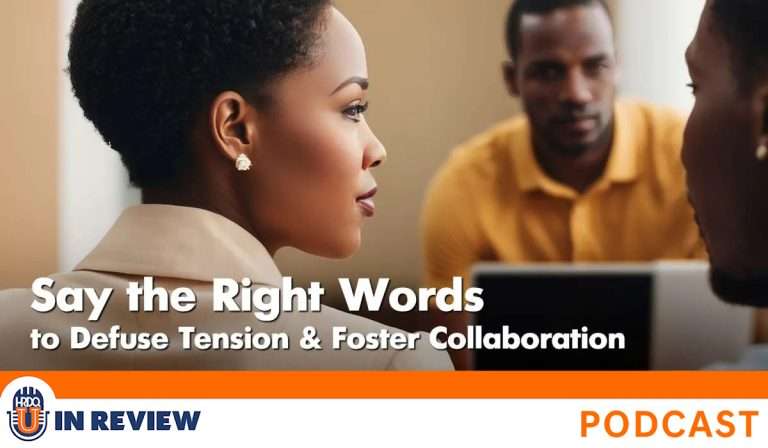
Listen to this podcast event at no charge with your
HRDQ-U Free Access Membership
In this episode, host Sarah sits down with David Dye and Karin Hurt, co-founders of Let’s Grow Leaders, to discuss their webinar Say the Right Words to Diffuse Tension and Foster Collaboration. They dive into insights from their latest book, Powerful Phrases for Dealing with Workplace Conflict, sharing practical strategies to navigate tension in the workplace.
David and Karin explore the shift to hybrid learning models post-pandemic, the evolving role of AI in L&D, and the human elements that remain essential in leadership development. They introduce the Synergy Stack, a team collaboration framework built on four key dimensions: connection, clarity, curiosity, and commitment.
The conversation is packed with actionable advice to manage tension in the workplace, including practical phrases for de-escalating conflict, real-world success stories, and tips for fostering a workplace culture of open communication. Tune in to discover how the right words can transform workplace relationships and collaboration!
Chapters:
⏱️ 00:00 – Introduction to David Dye & Karin Hurt
⏱️ 01:49 – Trends in Learning & Development
⏱️ 03:46 – The Synergy Stack Collaboration System
⏱️ 05:28 – Powerful Phrases for Conflict Resolution
⏱️ 07:29 – Key Takeaways & Practical Insights
⏱️ 16:24 – Creating a Culture of Open Communication
Listen now and start using powerful phrases to navigate tension in the workplace with confidence!
[ PODCAST PLAYBACK ]
You must be signed-in with your membership account to access this content.
Enjoyed this podcast? Have suggestions on how we can improve? Please take our quick survey and receive a coupon for 15% OFF any of our individual membership plans.
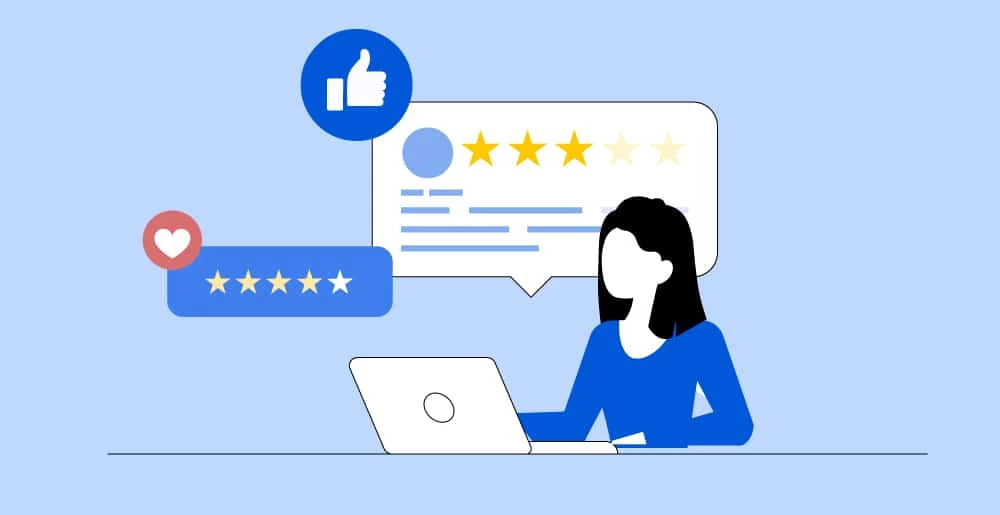
*Instant 15% coupon available upon completion of survey.
Want to learn more? Become an Individual or Corporate member to watch this and hundreds more webinars!
Maximize the potential of your team through collaboration. Learn how to foster a collaborative environment for success.

Karin Hurt, Founder and CEO, Let’s Grow Leaders
Karin Hurt is the founder and CEO of Let’s Grow Leaders, a global leadership development and training firm known for practical tools and leadership development programs that stick.
She’s the award-winning author of five books, including Courageous Cultures: How to Build Teams of Micro-Innovators, Problem Solvers, and Customer Advocates and Powerful Phrases for Dealing With Workplace Conflict, and she is the creator of the SynergyStack™ Team Development System.
A former Verizon Wireless executive and popular keynote speaker, Karin was named to Inc. Magazine’s list of great leadership speakers.
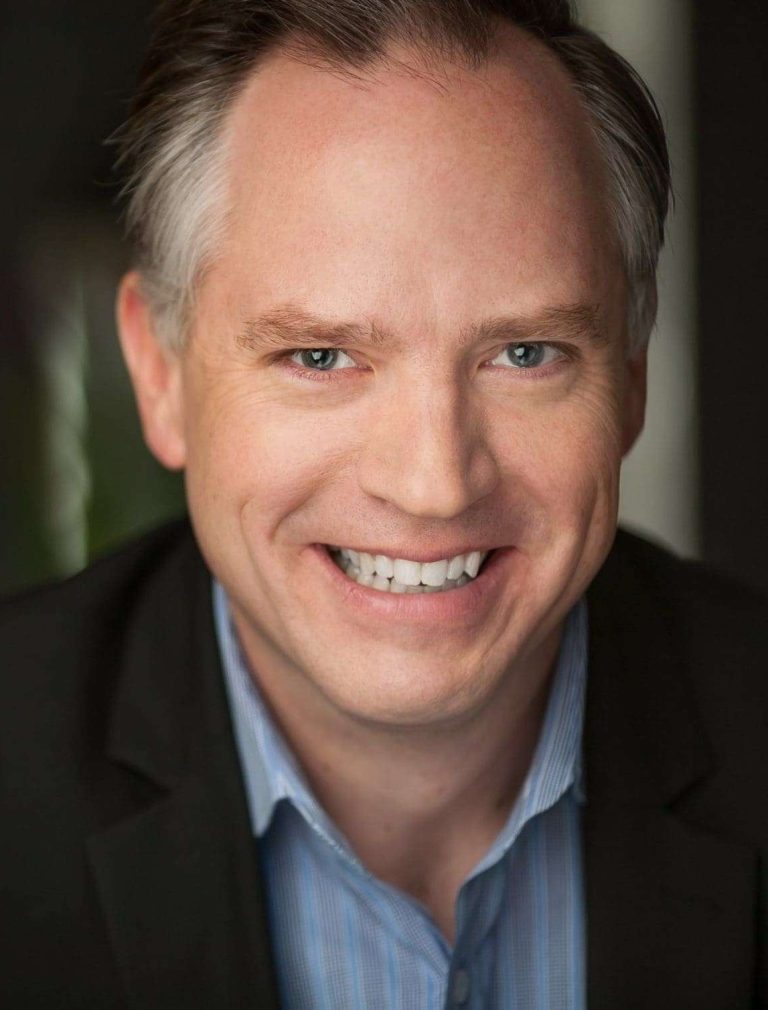
David Dye, President, Let’s Grow Leaders
David Dye is the President of Let’s Grow Leaders, a global leadership development and training firm known for practical tools and leadership development programs that stick.
He’s the award-winning author of multiple books, including Courageous Cultures: How to Build Teams of Micro-Innovators, Problem Solvers, and Customer Advocates and Powerful Phrases for Dealing With Workplace Conflict, and he is the creator of the SynergyStack™ Team Development System.
A former executive and elected official, David hosts the popular Leadership without Losing Your Soul podcast.
Karin and David are committed to their philanthropic initiative, Winning Wells – building clean water wells for the people of Cambodia.

Practical Leadership Development for Human-Centered Leaders
At Let’s Grow Leaders, we’re known for practical leadership development that sticks. We help leaders get breakthrough results, without losing their humanity through our leadership development programs and keynotes – and our new SynergyStack™ Team Development System.
Training Tools for Developing Great People Skills
This event is sponsored by HRDQ. For 45 years HRDQ has provided research-based, off-the-shelf soft-skills training resources for classroom, virtual, and online training. From assessments and workshops to experiential hands-on games, HRDQ helps organizations improve performance, increase job satisfaction, and more.

Navigating Difficult Conversations Customizable Courseware
Challenging discussions are a part of any workplace. Discover a seven-step approach to manage these conversations, which can help lessen stress and build trust. Participants will engage in realistic scenarios and role-playing to effectively handle confrontations.
Buy at HRDQstore.com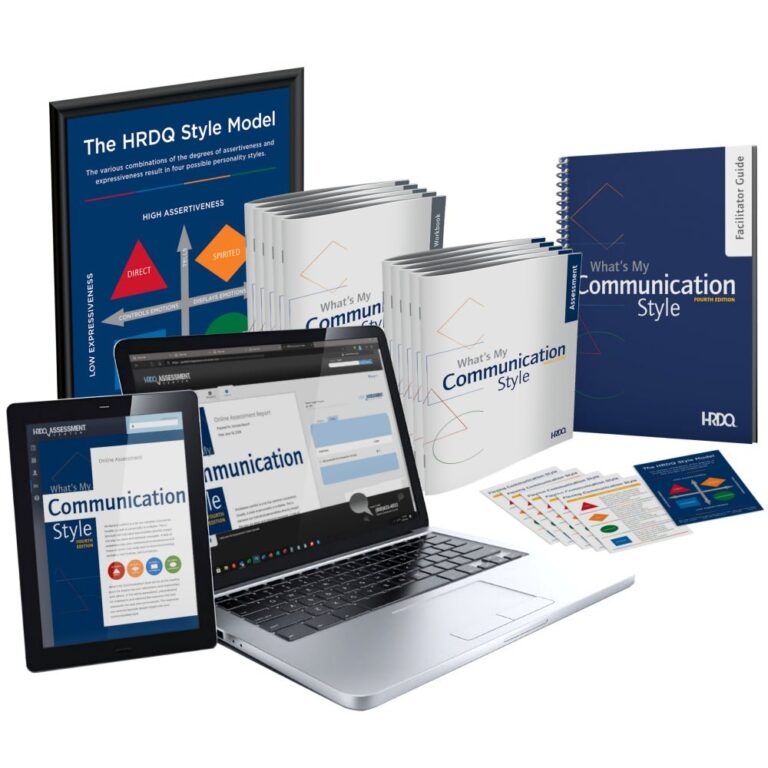
What's My Communication Style
Clear communication is essential for the success of any organization, yet differing communication styles can lead to conflicts. This assessment and optional workshop help individuals identify and adjust their communication methods to enhance interactions and reduce misunderstandings.
Buy at HRDQstore.comThe HRDQ-U In Review Podcast, brought to you by HRDQU.com, brings you the latest insights and practical tools for enhancing soft-skills training in your organization. As a learning community for trainers, coaches, consultants, managers, and anyone passionate about performance improvement, we interview subject matter experts and thought leaders from recent webinars they presented with us to take a deeper dive into the content they shared and answer all your questions. Join us as we explore new ideas and industry trends, share success stories, and discuss challenges faced by professionals.
The HRDQ-U In Review Podcast is intended for HR and training professionals, organizational development practitioners, and anyone interested in improving workplace performance and productivity.
New episodes of HRDQ-U In Review are released every week.
The length of the episodes varies, but they typically range from 15-30 minutes.
The podcast covers a wide range of topics related to HR and organizational development, including leadership development, team building, communication skills, conflict resolution, employee engagement, and more.
No, HRDQ-U In Review is completely free to listen to.
You can listen to any available HRDQ-U In Review Podcast right on our website at HRDQU.com via our embedded Spotify player on the related webinar page. In addition to our self-hosted option, you can find the HRDQ-U In Review Podcast on many of the popular streaming services, which are listed above.